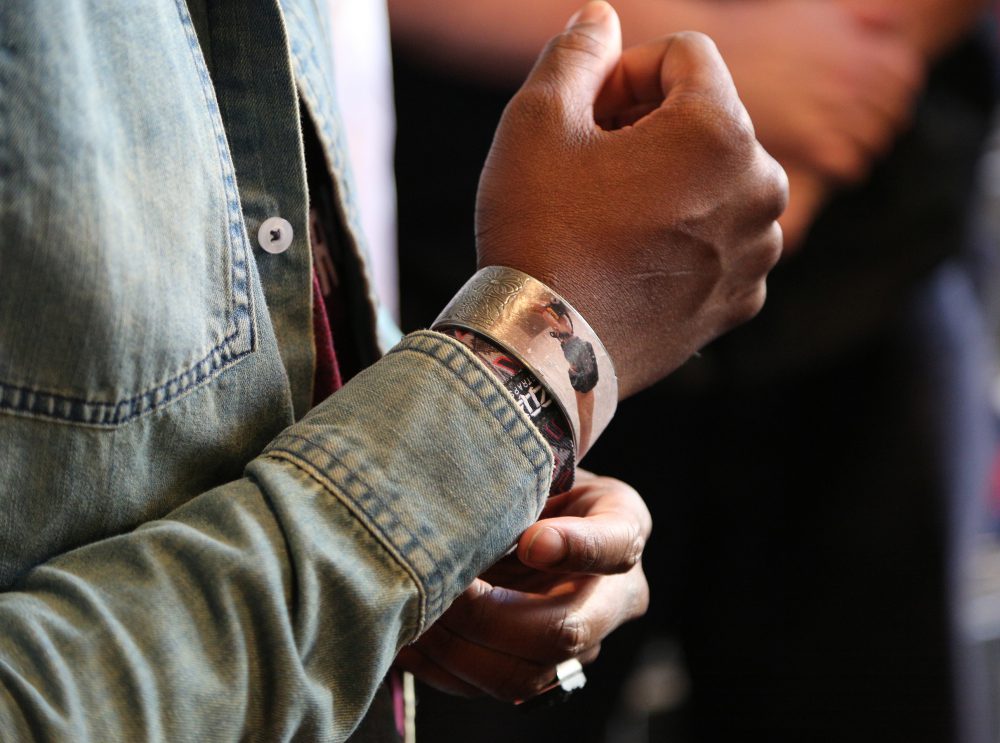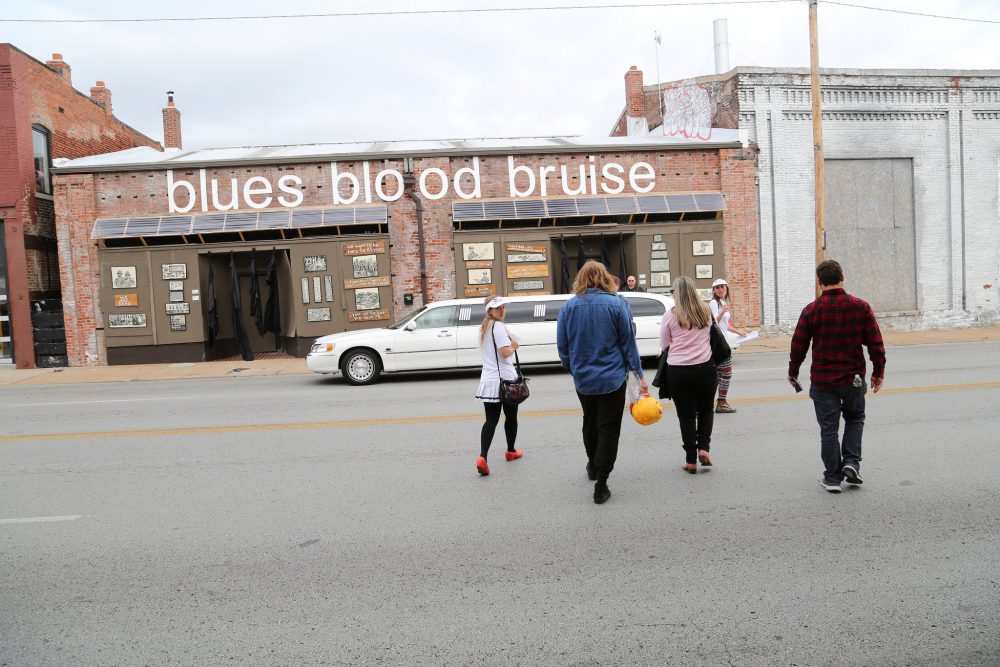The Currency of Place: The Mini Vinnie Bini Brings the Venice Biennale to the Streets
Journalist Esther Honig takes a tour of the Venice Biennale without leaving Kansas City.
Editor's Note
Continuing our ongoing explorations of the relationship between art and place, we asked three people—Katherine Cohn, Felicia Mings, and Esther Honig—to reflect on the culture of contemporary art biennials. Cohn and Mings participated in last year’s Independent Curators International Curatorial Intensive in New Orleans and traveled to the Venice Biennale as an extension of their research. After the blockbuster exhibition in Italy had closed, Honig visited the Mini Vinnie Bini in Kansas City, Missouri—an unauthorized recreation that brought artwork to restaurants, bars, and even an abandoned prison.
We’re publishing records of their experiences together to examine how place can affect our interpretations of art and to contemplate how art can—and does—exist outside of the world’s dominant art capitals.
And in case you didn’t make it to Venice or to Kansas City, Honig created the interactive map above, allowing you to wander through the Biennale (in its Mini Vinnie form) from the comfort of your desk.
On a Saturday afternoon in Kansas City, Missouri, I’m one of 15 people seated in a blue, full-size Ford van barreling down Troost Avenue. As a wink to our Bible Belt city, this event is called a “church van tour.” Our guides are Leone Reeves and Megan Mantia, who work collaboratively as Blanket Undercover. Over the next two and a half hours, Reeves and Mantia will shuttle us across the city to view their latest undertaking: a miniature recreation of the 56th Venice Biennale. The Biennale, hosted every other year in Italy, is one of the largest and most important international contemporary art exhibitions, spreading across the entire city. The 2015 iteration, titled “All The World’s Futures” and curated by Okwui Enwezor, contained works from 136 artists representing 89 countries. For the first time ever a small piece of that could be found in Kansas City, in the form of the Mini Vinnie Bini.
“This whole exhibition is an unauthorized recreation,” says Mantia, who traveled last July with Reeves to Venice for a week so that the pair could document the Biennale. “You have to really hustle to see everything,” says Reeves, who describes running from location to location, dripping with sweat in the summer heat, to photograph and record as much art as possible. The Biennale widely permits the documentation of works on view, which allowed the pair to amass roughly 10,000 photos and even film entire video installations. This documentation has been used in the Mini Vinnie Bini to loosely recreate the art, to display photos of the original work, and to show pirated videos on tablets and smartphones.
“You can think of [the Mini Vinnie Bini] as us showing you our scrapbook, but in 3D,” says Reeves. “Or like a Facebook album, but live” adds Mantia. The pair says that “robin-hooding” these materials was part of their vision for the project, to share the enriching and educational aspects of the Biennale without the hefty price of airfare.
In the mini biennial there are 30 pavilions—named after the exhibition spaces in Venice run by each participating nation—scattered across the city, and many are in places you wouldn’t expect to find art. The first stop on our tour is outside Operation Breakthrough, a local center for youth programming and social services. We come to the front of the building and crowd around a small wooden school desk that’s been chained to a steel pillar. The lacquered yellow wood is covered with scattered drawings in marker and pen. Among the chaos is a rough sketch of Mickey Mouse and a single sentence that reads: “fly like a eagle #justsayin.” This is the Mini Vinnie rendition of Oscar Murillo’s ongoing Frequencies series. The Colombian-born artist has visited middle and high schools across the world and applied canvases to students’ desks. Each canvas is left in place for an extended period of time, and the students are invited to decorate the surfaces as they please, allowing the youth to produce each work. Murillo has collected thousands of canvases, but this is the first time his project has been reproduced in the Midwest.
At Operation Breakthrough, three desks have been provided for students to write or draw on. Once the Mini Vinnie Bini has officially closed, after three months (exactly half the runtime of the Biennale), photos of the desks will be sent to Murillo. This is one of three projects in the mini biennial where the installations will be sent to the original artist, in the hope that these new versions will be incorporated alongside their official counterparts.

A “roaming pavilion” at the Mini Vinnie Bini in Kansas City, MO, displaying a work inspired by Jeremy Deller’s installation in Venice, Italy. Courtesy Blanket Undercover.
We pile back into the van and drive five minutes to the city’s main shopping center, the Country Club Plaza. It’s peak holiday spending season, but we’re there in search of a roaming pavilion. These “pavilions” are attached to local characters, often friends of Mantia and Reeves, who’ve agreed to participate by wearing or displaying a piece of Mini Vinnie Bini art. It’s one example of how the duo has reworked and built upon the original design of the Biennale. Each roaming pavilion serves as a walking gallery that can inform you about the piece and share the wearer’s own ideas.
Our group enters a local retail store to find an employee named Dwayne behind the counter. Despite a dozen perusing customers, he steps away from his post to roll up his sleeve and show the group a thick silver bracelet embossed with a small photo of a mannequin arm wearing the Motorola WT4000 tracking device. This bracelet is similar to the wearables used in Amazon warehouses to monitor the speed and efficiency of workers. The real device was on display at the Biennale in an exhibit by artist Jeremy Deller. In his work, Deller explores labor conditions during Britain's industrial revolution, alongside controversial contemporary practices, like workplace surveillance. As someone who works in retail, Dwayne was startled to learn the tracking device actually exists. “I was kinda like, whoa, that’s a bit extreme,” he says. From his experiences working at FedEx and other companies, he says he can relate to the stress of filling quotas and maintaining a quick work pace.
The geography of the Mini Vinnie Bini also breathes new life into the original works. At the Biennale in Venice, over the grand entrance to the Central Pavilion in the Giardini, a neon text by Glenn Ligon reads, “blues blood bruise.” In Kansas City, Reeves and Mantia have recreated the same giant white text and hung it on the side of a smaller brick building. It is a reference to “Come Out,” a piece by composer Steve Reich, which sampled the testimony of Daniel Hamm, a man wrongly accused of murder after the 1964 Harlem riots. (“I had to open the bruise up to let some of the blues…blood come out to show them.”) In Kansas City, the work has a sobering presence. After all, the city is only a three and a half-hour drive from Ferguson, Missouri, where Michael Brown was shot dead in 2014. “Time has repeated itself,” says Reeves, who finds beauty in the simple gesture that distills the legacy of police brutality into “three words in Helvetica font.”

The Mini Vinnie Bini recreation of Glenn Ligon’s A Small Band, 2015, in Kansas City, MO. Courtesy Blanket Undercover.
More so than in previous years, the work at the 2015 Venice Biennale explicitly explored themes of social unrest. Each day, artist and filmmaker Isaac Julien directed a straightforward reading from Karl Marx’s Das Kapital, offering an essential historical perspective on the formation of capitalism. The Mini Vinnie Bini has taken that a step further, replacing the performance with a weekly book club. Reeves says the organizers wanted to make the dense text more accessible and to bring together people with different viewpoints “It’s been one of my favorite things” she says, “People get so into it.” Reeves and Mantia have expanded the presence of the Mini Vinnie Bini through dozens of other curated events, such as film screenings, live performances, as well as talks and dinners.
The approach to the mini biennial is fundamentally DIY, where inclusivity and creativity take priority. “Art is not a secret club or a secret language that you’re not allowed to know because you don’t know that language,” says Reeves. Breaking down those barriers is a theme at the Mini Vinnie Bini and is part of the larger mission of Blanket Undercover. “We do a lot of silly work and a lot of parody work,” says Mantia, “but for this, it’s actually a very earnest attempt to share what we saw so that people feel in some small way that they’ve been.”
Jumping on a plane to Venice is not a privilege shared by everyone, and the objective of the Mini Vinnie Bini is to allow more people to join the larger critical conversation of how art can function. The exhibition and all associated events are free of charge, and no profits were made. (All expenses were funded through the local Rocket Grants program.) Mantia jokes that in many ways they’re bringing the Biennale to the streets: “We’re doing it from an artistic thought background and are giving ourselves leeway to have fun with it.”
On one of our final stops, we come to the historic Workhouse Castle on 21st and Vine. This castle was once a jail, where prisoners were required to perform hard labor as part of their sentence, including the construction of the castle itself. There we find another piece inspired by Jeremy Deller’s installation in Venice. Strung to the yellow limestone brick, a large black cloth flag is embroidered with the notice, “Hello, today you have day off.” Messages like this are often used to alert contract workers that their services are not required for the day. The disjointed sentence exemplifies a global labor market where the human element, a boss, has been replaced by an automated digital platform. One man on my tour says he’s seen this message before. “I had a day laboring job where I would get that exact message,” he says. “You feel like you’re sort of in a limbo...they could just text me at anytime and say ‘oh we don’t have any work for you.’”
Mantia and Reeves reached out to Enwezor for an interview, and to share their project with him, but didn’t hear back. Regardless, they plan to mail him documentation from the Mini Vinnie Bini. They think he’ll be pleased to learn how they’ve reinterpreted it.



